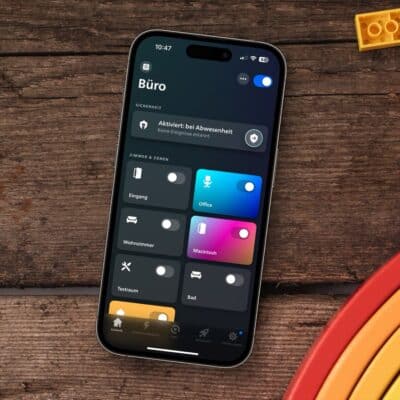It is a long time since everything that has Philips written on it has also had Philips in it. Today we want to take care of the two best known examples and a resulting problem. Philips televisions are actually made by TP Vision – and Philips Hue has already split off from Philips as a Signify company.
And precisely with these two brands from the end consumer sector “Philips” offers really great technology: Ambilight televisions are unique on the market, and the smart lighting system Philips Hue is the undisputed market leader. But it is exactly the fusion of these two systems that leaves a lot of potential untapped.
Ambilight+Hue should be linked to Hue Entertainment
Although Ambilight TVs have for many years offered a function to extend the lighting effects behind the TV to Hue lamps, integration is still quite rudimentary despite the improved latency around two years ago.
The best example of this is that all settings for the Hue lamps must be made in the TV’s menu, and there are only a few fixed positions available for the lamps. As a user, you have relatively few settings here to adjust the lighting experience even better to your own wishes.
The Hue Sync App and the official Hue App offer exactly these possibilities. Here, several entertainment areas can be created with different lamps, and the lamps can be placed much better in the room, thus improving the lighting effects. In addition, the HDMI Sync Box allows you to select different modes and effect levels for the various HDMI inputs.
There’s no question that Philips TVs – or rather TP Vision – would also benefit from these options and possibilities.
There’s still a lot of potential the other way around, too
But also in the other direction I can imagine some possibilities. The first thing I think of here is of course the lounge effect of the Ambilight TVs. If you press the Ambilight button on the remote control, the switched-off TV can be used as mood light. The LEDs on the back can then light up in different colours.
And it’s precisely this function that makes me wonder: why not go one step further? Why can’t you control the switched-off Ambilight TV as a light source via the Hue-App? It would be wonderful if this LEDs could be integrated into scenes for the whole living room or controlled with a Hue switch
My wish for the future
Currently I imagine the work between Signify and TP Vision to be as follows: The developers of Signify have created a quite extensive API around Philips Hue and Hue Entertainment that can be used by all developers. It is exactly that kind of interface that the developers of TP Vision use to create Ambilight+Hue. Concrete communication does not seem to take place, as is repeatedly made clear by problems – for example, the new Hue products sometimes reproduce the wrong Ambilight colors.
Why don’t TP Vision and Signify put together a joint team to work together, at least for a second time, on the improvement and new functions of Ambilight+Hue? In the end, not only both brands could benefit from this, but also the customer.
Note: This article contains affiliate links. We receive a commission for purchases via these links, which we use to finance this blog. The purchase price remains unchanged for you.


























I have been trying to do this for years! 🙁
I bought a 4k 50″ Philips Ambilight TV on the belief this would be possible due to the same brand name! And I have been running Philips Hue for years. So I find it mind-blowing that this still does not work.. In fact because of this lack of integration, I will be buying a Samsung ART TV (with a HDMI Sync Box) next instead of another Philips/TP Vision.
Sadly this is clearly a leadership problem at TP Vision, not Signify, as the Philips Hue platform already exposes a fully featured API (I have even programmed against this API myself to enable voice control of lights). So it is just down to the TP Vision people to write the code to implement this API via the Hue Bridge properly (and report any bugs to Signify).
Does this hueblog have any contacts at TP Vision? If they cannot figure out the value of this for themselves maybe we can make some noise?
Thanks for a great post and sharing this issue